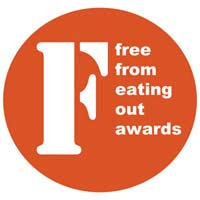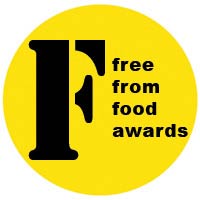I’m feeling a bit demoralised today. 10 years in, and we’re still having to explain at every step …
My coeliac daughter – who has been on many residentials, with her primary school, with both Brownies and Guides, and also for week-long residential holidays, has just gone up to secondary school. As part of their induction, the Year 7 classes (180 children) are going off for a 3-day team-building session.
 I think that’s a wonderful thing, and she’s looking forward to it. I have no worries at all about the residential itself. She’s not going to be homesick, she’s going to enjoy the activities, she’s going to make friends. But I am worried about the food.
I think that’s a wonderful thing, and she’s looking forward to it. I have no worries at all about the residential itself. She’s not going to be homesick, she’s going to enjoy the activities, she’s going to make friends. But I am worried about the food.
Usually when I send my daughter on these events, I send a pack of gluten free staples as needed – bread, perhaps pasta, some cake etc. So I asked the school to find out what I should send.
The centre the children are going to is a dedicated centre for activity sessions for schools, and advertises itself as able to cope with special diets. However – on being notified that my daughter is a coeliac, the centre says “tell us what she needs, and we’ll get it”.
Well, that’s a kind offer, but is it me, or is this just not reassuring? What are their menus? How will I know what she needs to match what they’re providing? If they don’t know what she needs, how will they understand about the cross-contamination issues? What if I provide a list, but they’re offering something I haven’t thought of, and assume it’s OK for her to eat because it’s not on the list?
Suppose they only do one of these 3-day courses each week – that is 180 children for us, but they cater for up to 300. Statistics says that here in the UK at least one and maybe three of those children each week will need a gluten free diet. Surely, surely, they’ve met this before …
The answer to that question “what does she need?” ranges from the very brief, easy answer, to the extensive, list-everything-and-explain-what-she-can/can’t-eat.
1. She needs a gluten free diet.
OK – that is too brief. Virtually nobody in the ‘normal’ world understands the extent to which gluten infiltrates the diet.
2. She needs a diet free from wheat, barley and rye – and contaminated oats.
Better – but still not clear enough, as you can’t be sure that people will understand that ‘flour’ comes from wheat, and that this will include rusk, and breadcrumbs and pastry and pasta and cake and … And that is before you get into questions about gravy, custard, soft drinks etc.
Somebody was looking for help on the gluten free diet this week, and found my site with the question “is there gluten in toast?” Well, yes there is – unless you make the toast with gluten free bread. And even then, you have to make it in a way that doesn’t get ordinary breadcrumbs mixed up with it in the cooking. So you see, you can’t assume people will understand …
3. So do we spell it out?
She needs breakfast – so, maybe special breakfast cereal, bread, yoghurt, sausages, baked beans … what are you offering the others for breakfast?
She needs snacks – so, special biscuits or cake perhaps – or at least fruit.
She needs a midday meal and an evening meal, and maybe a supper – so what are the others having? If it’s packed lunches, she’ll need special bread, crisps, biscuits …. If it’s a cooked meal, she’ll need … well, you get the idea. Every meal needs to be thought through and alternatives identified.
What does she need? isn’t really an appropriate question. Particularly if I’ve already given them answers 1 and 2, and explained the need for 3.
I feel dispirited.
 |
I’ve written a book summarising what we’ve learnt over 20 years of dealing with the gluten free diet, and it might be just what you’re looking for. It packs the lessons we’ve learned into what I hope is a helpful and straightforward guidebook. It’s available on Amazon, as a paperback or for your Kindle… |





Don’t give up and be strong with them. I would call whoever is in charge of this trip and just plainly explain the very serious situation. Listen, in today’s world, teachers/staff have to deal with many parents and special situations. Give them your mobile number, have them reach out to you during the 3-day session and get their number as well, so you can check in with them. Be a pest with them – they’ll get to know you and understand the situation and tell them it’s either your daughter has to watch VERY carefully what she eats, or the staff gets to clean up her big “D” – that’ll get their attention ;-)
Ha! You’re so right, Steve … and she reacts by vomiting as well, so that would be pleasant too, no?
I would pester the heck out of them until they give you the amount of detail you feel comfortable with. These folks deal with children every day, and if they can’t grasp that her health is the most important issue in your life, they are in the wrong profession.
So, 1)Be Polite, 2)Be Consistent, 3)Be Persistent. IF they can’t provide you with a menu via fax or email that you can offer your substitution suggestions for, then provide them with a “menu” of your own that lists what she normally eats in a day that they can match.
I would include a list of normal kid “don’ts” for these events. (I’m going on American Schools, AND I homeschool so I’m doubley handicapped on this one) Such as;
No bread products containing wheat, rye, barley or oats. THis includes items such as pizza, muffins, crackers, cookies etc. Most breakfast cereals.
No prepackaged foods that may contain wheat as a binder, filler, or decaking agent, for example mass produced dehydrated potato products (au gratin, scalloped etc) and premade egg mixes.
Processed meats, and meats with coatings. Most coatings are made with wheat flour, or breadcrumbs made with wheat flour.
What she can have: Eggs, hard boiled, fried, or scrambled made from scratch, fresh fruit, bread products marked gluten free (Containing NO wheat, rye, barley or oats), unprocessed meats with NO coatings. Fresh vegetables, and salads with dressings that are labeled gluten free. Potatoes, mashed, boiled, baked made from scratch. (*French fried potatoes must be avoided because of cross contamination in fryolators.)
I would add condiments with brand names to this list as you feel comfortable with. IF you pass this information on to them… it should be good enough to get her through the 3 days…..
Here in the US… what she would get..would be Pizza, sandwiches, hamburgers with tater tots (kind of a fried shredded potato thing) Hot Dogs, eggs, pancakes, sausages and fresh fruit, juice and a soda or two along with all the water she could drink. Oh and the mandatory vegetables…which unfortunately I believe includes ketchup????
Hope this helps. I can understand your frustration. It’s scary to think about, I can’t imagine if my child had a peanut allergy. Here in the US I think they have actual “peanut” tables so the kids don’t have to even sit near anyone eating the dreaded Peanut butter and jelly… I wish they were that sensitive to the wheat issue. If my daughter went to public school (different from your public school I think?) I would be afraid of cross contaimination at the lunch table.
The idea of the kids talking and crumbs flying…hands moving across the table, food getting thrown?? How can your child not get wheat in their food sitting next to someone having a ham and cheese on whole wheat?
Oh well, I’m babbling and it’s very late. All the best.
Laney
Laney, thank you for your extensive comment (especially if it was very late where you are!). I’m going to copy your list (and edit it a bit for the UK) and then fax it to school and to the centre. Good idea.